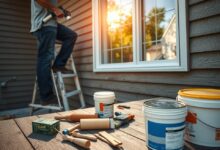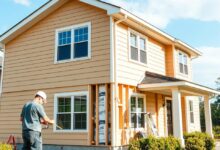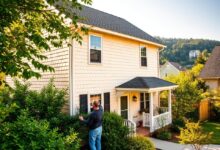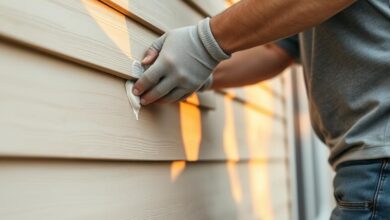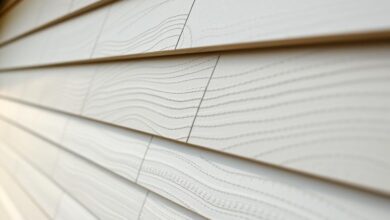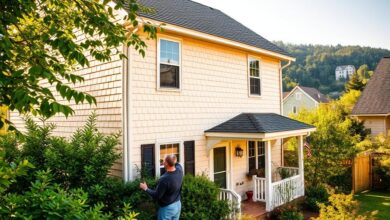Discover the Top Siding Options for Optimal Home Insulation
A well-insulated home is key for energy efficiency and comfort. The right siding is essential. It protects your home and boosts insulation.
Choosing the best siding for home insulation can cut energy costs. It also makes your home more comfortable. We’ll look at the top siding options for better insulation. This will help you make a smart choice.
Key Takeaways
- Understanding the role of siding in home insulation
- Exploring top siding materials for energy efficiency
- Benefits of choosing insulated siding for your home
- Factors to consider when selecting siding for optimal insulation
- How the right siding can reduce energy costs
Understanding Home Insulation and Siding
It’s important to know how siding and home insulation work together for energy efficiency. Many homeowners don’t realize siding’s role in keeping their homes warm and energy bills low.
The Relationship Between Siding and Energy Efficiency
The siding you choose can greatly affect your home’s energy use. Siding protects your home from outside weather, keeping the inside temperature steady. By picking the right siding, you can cut down on heat loss in winter and heat gain in summer. This boosts your home’s energy efficiency.
R-Value and What It Means for Your Home
The R-value shows how well a material stops heat flow. For home insulation, a higher R-value means better insulation. When picking siding, think about its R-value and how it helps your home’s energy efficiency. Knowing this helps you make smart siding choices.
Best Siding for Home Insulation: Top Materials Compared
Choosing the right siding for your home is key to saving energy and money. Each material has its own benefits and drawbacks. The best siding can make your home more comfortable and energy-efficient.
Vinyl Siding with Insulation Backing
Overview
Vinyl siding with insulation is a top pick for many homeowners. It’s both energy-efficient and affordable. This siding combines vinyl’s durability with insulation’s benefits.
Pros
- Improved Energy Efficiency: The insulation backing keeps your home cozy in winter and cool in summer.
- Cost-Effective: Vinyl siding is cheaper than many other options, and the insulation makes it even better.
- Low Maintenance: Vinyl siding is durable and easy to care for.
Cons
- Limited R-Value: While it’s better than regular vinyl, its R-value isn’t as high as some other options.
- Aesthetic Limitations: Some might find vinyl siding less appealing than other materials.
Features
Vinyl siding with insulation comes in many styles and colors. It’s also pest- and weather-resistant.
Fiber Cement Siding
Overview
Fiber cement siding is durable and versatile. It’s made from cement, sand, and cellulose fibers. It looks good and lasts long.
Pros
- Durability: It withstands weather, pests, and fire well.
- Aesthetic Versatility: It can look like wood or other materials, giving you design freedom.
Cons
- Higher Cost: It’s pricier than vinyl siding.
- Installation Challenges: It needs special installation due to its weight and composition.
Features
Fiber cement siding lasts a long time and resists damage. You can paint it to match your home’s color scheme.
Insulated Metal Siding
Overview
Insulated metal siding is durable and energy-efficient. It’s a modern, low-maintenance choice for homeowners.
Pros
- Energy Efficiency: It saves a lot of energy thanks to its high R-value.
- Durability: Metal siding resists pests, weather, and fire.
Cons
- Higher Upfront Cost: It’s more expensive than other options.
- Noise: Metal siding can be noisy during rain or hail.
Features
Insulated metal siding comes in various finishes. It can look like other materials. It’s also mold- and mildew-resistant.
Wood and Engineered Wood Options
Overview
Wood and engineered wood siding offer a natural look. They can be durable if well-maintained.
Pros
- Natural Appearance: Wood siding adds a unique beauty to homes.
- Durability: Engineered wood is more stable and less prone to warping than regular wood.
Cons
- Maintenance: Wood siding needs regular care to avoid damage from weather and pests.
- Cost: High-quality wood and engineered wood can be pricey.
Features
Engineered wood siding is less likely to shrink or expand with temperature changes. It’s more stable than traditional wood.
| Siding Material | Energy Efficiency | Durability | Maintenance | Cost |
|---|---|---|---|---|
| Vinyl Siding with Insulation Backing | High | Medium | Low | Medium |
| Fiber Cement Siding | Medium | High | Medium | High |
| Insulated Metal Siding | High | High | Low | High |
| Wood and Engineered Wood | Low-Medium | Medium-High | High | Medium-High |
Each siding material has its own strengths and weaknesses. Homeowners should think about their needs, budget, and preferences when choosing the best siding for their home.
“The right siding can make a significant difference in a home’s energy efficiency and overall appearance. It’s essential to weigh the pros and cons of each material before making a decision.”
Top-Rated Insulated Vinyl Siding Products
Many people look for the best siding for their homes. They want something that looks good and saves energy too.
ProVia Insulated Vinyl Siding
Overview
ProVia Insulated Vinyl Siding is known for being tough and saving energy. It comes in many styles and colors to match any home.
Pros
- Energy Efficiency: Keeps homes cooler in summer and warmer in winter.
- Durability: Can handle harsh weather.
Cons
- Higher Upfront Cost: Costs more than non-insulated siding.
- Limited Availability: Not found everywhere.
Recommendations
ProVia Insulated Vinyl Siding is great for those who value energy savings and durability.
CertainTeed Insulated Siding
Overview
CertainTeed Insulated Siding combines style, toughness, and energy saving. It makes homes comfortable and cuts down on energy bills.
Pros
- Excellent Insulation: Keeps homes warm in winter and cool in summer.
- Variety of Styles: Offers many design choices.
Cons
- Installation Challenges: Needs a pro to install.
- Cost: More expensive than regular siding.
Recommendations
CertainTeed Insulated Siding is perfect for those who want both looks and energy savings.
Mastic by Ply Gem Insulated Siding
Overview
Mastic by Ply Gem Insulated Siding lasts long and saves energy. It comes in many styles to fit any home.
Pros
- Durable: Resists fading, cracking, and damage.
- Energy Savings: Lowers heating and cooling costs.
Cons
- Color Limitations: Fewer color options than some brands.
- Installation: Needs proper installation for best results.
Recommendations
Mastic by Ply Gem Insulated Siding is ideal for those who want durability and energy savings.
Cost vs. Energy Savings Analysis
When choosing insulated vinyl siding, consider the cost and energy savings. Here’s a comparison:
| Product | Average Cost per Sq. Ft. | Potential Energy Savings |
|---|---|---|
| ProVia Insulated Vinyl Siding | $3.50 – $4.50 | Up to 20% |
| CertainTeed Insulated Siding | $3.00 – $4.00 | Up to 25% |
| Mastic by Ply Gem Insulated Siding | $3.25 – $4.25 | Up to 22% |
Premium Fiber Cement and Engineered Wood Options
Fiber cement and engineered wood are top choices for siding. They are durable and look great. Homeowners love them for their performance and style.
James Hardie Fiber Cement Siding
Overview
James Hardie Fiber Cement Siding is a favorite for its toughness. It’s made from cement, sand, and cellulose fibers. This makes it strong and lasts a long time.
Pros
Durability: It can handle tough weather like strong winds and heavy rain. It also keeps pests and fire away.
Aesthetic Versatility: It comes in many styles and colors. This means it fits many house designs.
Cons
James Hardie siding is heavy. This makes it hard to install and can cost more. It also needs regular care to avoid cracks.
Recommendations
James Hardie Fiber Cement Siding is a good pick for durability and looks. But, make sure to hire skilled installers for the best results.
LP SmartSide Engineered Wood Siding
Overview
LP SmartSide Engineered Wood Siding combines wood’s beauty with durability. It’s made from wood fibers, resins, and additives.
Pros
Cost-Effective: It’s cheaper than real wood but looks similar. It’s also good for the wallet.
Resistance to Rot and Insects: The special process makes it strong against rot, decay, and bugs.
Cons
LP SmartSide is durable but can get damaged by bad weather if not cared for.
Recommendations
LP SmartSide is a smart choice for those who want a mix of cost and quality. Keeping it well-maintained is important.
Installation and Maintenance Considerations
Getting your siding installed right and keeping it up is key. Work with experts to ensure it’s done well. Follow the manufacturer’s care tips to keep it looking good.
Climate-Specific Siding Recommendations
Choosing the right siding is key, as different climates across the U.S. present unique challenges. From freezing winters to hot summers, the right siding boosts energy efficiency and durability.
Best Insulated Siding for Cold Northern Climates
In cold areas, insulation is vital. Insulated vinyl siding is a top pick because it keeps warmth in and cold out. Brands like ProVia and CertainTeed offer high-quality options for harsh winters.
Optimal Choices for Hot Southern Regions
In hot areas, siding must reflect sunlight and handle high temperatures. Insulated metal siding is a smart choice, as it can be coated for reflection. Some fiber cement siding also works well in southern climates.
Solutions for Mixed and Humid Climates
In mixed or humid climates, siding must be adaptable. Engineered wood siding, like LP SmartSide, is moisture-resistant and handles temperature changes. Proper installation and care prevent warping or rotting.
Energy Star Certified Options for Maximum Efficiency
For those aiming for top energy efficiency, Energy Star certified siding is ideal. These products meet EPA energy standards. They offer insulation and help save energy in your home.
Conclusion: Making the Right Siding Investment for Long-Term Savings
Choosing the right siding for your home is key. It can greatly affect your energy bills and save you money in the long run. High energy efficiency siding can cut down on heating and cooling costs. It also makes your home more comfortable and valuable.
There are many siding options to choose from. ProVia and CertainTeed offer insulated vinyl siding. James Hardie has fiber cement siding, and LP SmartSide provides engineered wood siding. Each has its own benefits for different climates and tastes.
When picking siding, think about R-value, climate, and installation costs. This way, you can make a smart choice that saves you money over time.
The best siding choice can make your home more energy efficient. This means less work for your heating and cooling systems and lower bills. By choosing energy-efficient siding, you make your home more comfortable. You also help the environment.


